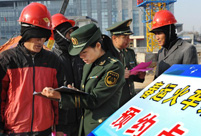 'Jin' named the word of the year by cross-strait netizens
'Jin' named the word of the year by cross-strait netizens Chinese scientific expedition goes to build new Antarctica station
Chinese scientific expedition goes to build new Antarctica station
 Chinese naval escort fleet conducts replenishment in Indian Ocean
Chinese naval escort fleet conducts replenishment in Indian Ocean 17th joint patrol of Mekong River to start
17th joint patrol of Mekong River to start China's moon rover, lander photograph each other
China's moon rover, lander photograph each other Teaming up against polluters
Teaming up against polluters
 |
| Tourists wear filter masks in Beijing on Wednesday to avoid inhaling pollutants. Hebei, Beijing, Tianjin, and five provinces in central and eastern China have suffered heavy smog recently. (China Daily/Yan Xiaoqing) |
After Tianjin drivers were confused by traffic-restriction orders from local environmental and transportation bureaus during a succession of smoggy days early this week, the need for timely smog alerts and forecasts has become urgent, authorities said.
The China Meteorological Administration and the Ministry of Environmental Protection signed a cooperation framework on Tuesday to strengthen forecasting during stretches of heavy pollution.
It is the latest measure taken after the publication in September of a detailed action plan to tackle air pollution. The plan said coal consumption will be cut and new industrial projects, such as power plants and steel mills in key cities and regions, including Beijing and the Yangtze River Delta, will be banned.
The framework said when weather conditions are likely to bring severe smog, the national weather and environment authorities will activate a joint discussion mechanism and issue air pollution alerts together.
Feng Lei, deputy director of the disaster relief department under the China Meteorological Administration, said the cooperation between the two bodies will enhance the air quality forecasts and warnings.
He added that a trial project in urban air quality forecasting would be launched to help locals learn about expected air conditions in advance.
The framework emphasized information sharing between the two. That information includes air quality monitoring data, weather satellite data and atmospheric data.
China has been under heavy pressure to address the causes of air pollution as thick and hazardous smog has frequently engulfed the country since early this year. Severe air pollution even forced people clad in Santa Claus clothes delivering gifts on the streets of Beijing to wear anti-dust respirators on Christmas Eve, which fell on Tuesday.
According to the National Meteorological Center, thick smog shrouded Beijing, Tianjin, Hebei, Shanxi, Shandong, Henan, Shaanxi and Jiangsu on Wednesday.
The sky is expected to clear to blue on Thursday with a cold snap blowing the haze away on Wednesday evening, the National Meteorological Center said on Wednesday.
Temperatures in central and eastern China will see dramatic drops of up to 10 degrees Celsius before Friday, according to the NMC’s weather forecast.
The choking smog shut down highways and forced schools to suspend outdoor activities in parts of the region since Sunday.
In Shandong and Hebei, some primary schools suspended outdoor activities for health reasons.
"All sports and exercises were taken indoors because of the heavy pollution," Xu Shuhai, vice-president of No 8 Middle School in Hengshui, Hebei province, told Xinhua News Agency on Wednesday.
Research published in the Proceedings of the National Academy of Sciences, a US multidisciplinary scientific magazine, in July, said that air pollution from burning coal caused people in northern China to live an average of 5.5 years less than those living in the south. Coal has been used to provide heat to the north for decades.
"The study gives a clear answer to the link between life expectancy and air pollution," Li Hongbin said in an earlier interview with China Daily. Li is an economics professor at Tsinghua University School of Economics and Management in Beijing who collaborated with researchers in China, the US and Israel on the study.
A monitoring network would be established in 16 provinces to study the influence of air pollution on health, over the next five years, health authorities said.
 People prepare for upcoming 'Chunyun'
People prepare for upcoming 'Chunyun'  Highlights of Beijing int'l luxury show
Highlights of Beijing int'l luxury show Record of Chinese expressions in 2013
Record of Chinese expressions in 2013 China's moon rover, lander photograph each other
China's moon rover, lander photograph each other 17th joint patrol of Mekong River to start
17th joint patrol of Mekong River to start Spring City Kunming witnesses snowfall
Spring City Kunming witnesses snowfall Heritage of Jinghu, arts of strings
Heritage of Jinghu, arts of strings Weekly Sports Photos
Weekly Sports Photos PLA elite units unveiled
PLA elite units unveiled  China's stealth fighters hold drill over plateau
China's stealth fighters hold drill over plateau Chinese navy hospital ship's mission
Chinese navy hospital ship's mission  "Free lunch" program initiated in NW China
"Free lunch" program initiated in NW China  Rime scenery in Mount Huangshan
Rime scenery in Mount Huangshan DPRK's Kaesong Industrial Complex
DPRK's Kaesong Industrial Complex 'Jin' named the word of the year
'Jin' named the word of the year Day|Week|Month